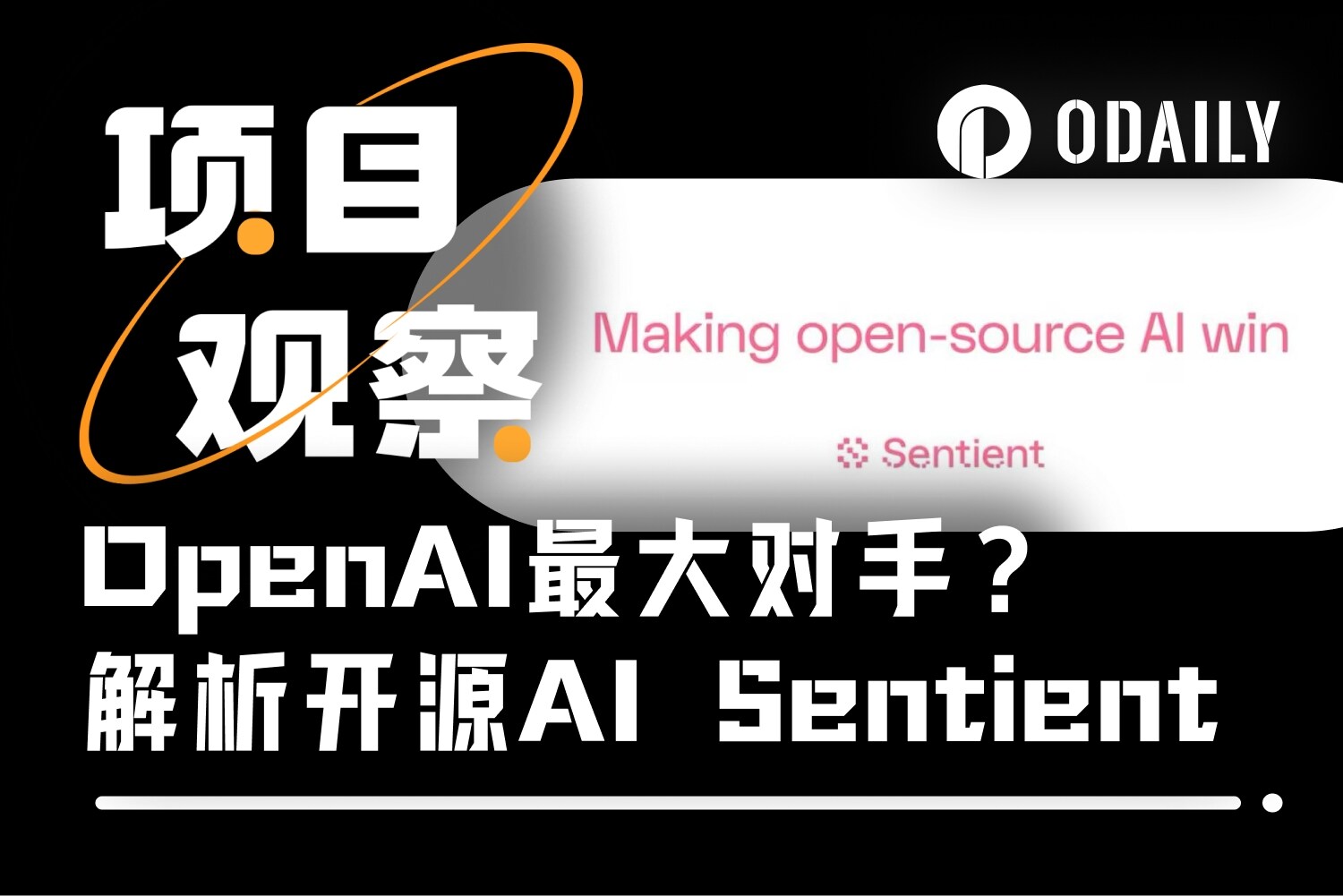OP Research: AA Wallet Evolution Illustration
Original author: CloudY, Jam
summary
But in fact, the Ethereum EOA account used for comparison is a relatively primitive product, specifically:
The account control rights are single, only signature authorization and non-signature. Whether it is a transaction worth 1 US dollars or a transaction of 100 million US dollars, you need to approve first, and then sign to confirm the transaction. Then there is only one signature difference between the defrauded permission and the normal transaction, which makes every new user frightened when interacting. Although Metamask now allows users to choose the amount of approval when approving token permissions, for frequent interactions, instead of consuming gas fees for multiple approves, users prefer to directly authorize the upper limit. Compared with the Web2 account model like Two Factor Authentication (2 FA) or U-shield to control large-amount transaction risks, and face scanning or password-free payment to facilitate small-amount transactions, EOA accounts are very dull and difficult to use.
The gas fee threshold is too high and blocks a large number of new users. Layer 2 such as Ethereum mainnet and Optimism/Arbitrum use ETH tokens as Gas tokens, which requires users to convert fiat currency into U.S. dollar stable currency, then further convert it into ETH, and then transfer the ETH into the wallet. Many users discovered that they needed ETH as Gas after transferring the USD stablecoin to their wallets, and had to purchase ETH again. Whats more, public chains such as BSC/Polygon/Solana all use their own Gas tokens, which is another pitfall that newcomers must step into. In addition, many users do not really want to purchase spot Gas tokens, but they have to leave a large amount of redundant Gas tokens in their wallets because of the need for on-chain interaction.
Vitalik has actually known that EOA accounts are so difficult to use. The Ethereum team is also trying to solve this problem, and account abstraction is one of the solutions. However, due to the inability to modify the underlying consensus of Ethereum for account abstraction, it was not until the proposal of ERC-4337, a smart contract wallet based on the application layer, that account abstraction really gained attention and became a hot topic.
After a brief introduction to account abstraction and ERC-4337, this article will speculate on the future evolution of the Web3 account system and the ownership of traffic entrances based on the application of account abstraction and the development of the Web2 account system.
From an ecological perspective, in the past, users needed to use EOA to perform complex on-chain operations, and due to the current limited ecological development on the chain, only limited protocols can be provided, and the actual needs of users cannot be effectively met. The account abstraction simplifies the execution of the above operations. Only the user input is needed to obtain the output. There are no more frequent clicks and cumbersome signatures.It can be said that the implementation of AA has transformed the on-chain ecology from seller-dominated to buyer-dominated.
Account Abstraction and ERC-4337
What does Account Abstraction (hereinafter referred to as AA) specifically refer to?Abstract the underlying technology and data structures to simplify the steps for users and developers. A simple understanding is the functionality of implementing CA on the basis of EOA.
ERC-4337 became the basic standard for AA. ERC-4337 introduces UserOperation, which is a special transaction that expresses user intent and allows contract accounts to actively perform operations. These UserOperations are managed by a role called Bundler, which simulates executing UserOperations and adds valid operations to a special transaction pool. The EntryPoint contract then verifies and executes these UserOperations to fulfill the users intent.
account type
There are two main types of accounts in Ethereum: EOA (Externally Owned Account) accounts and Contract Accounts.
The address length of an EOA account is 20 bytes and is calculated from the private key generated when the user is created and the public key generated by the elliptic curve encryption algorithm. EOA account status includes the number of transactions (Nonce) and the number of assets (Balance). The addresses of contract accounts are also 20 bytes, but they are calculated from the sender address and Nonce of the contract creation transaction. The contract account status includes the number of contracts (Nonce), the number of assets (Balance), the code hash (CodeHash) and the storage root hash (StorageRoot), which is used to store the root node hash value of the Merkle Patricia Trie tree of the contract data.
Account type and status information are critical to transactions and smart contract execution on Ethereum, and are the differences between EOA and CA.
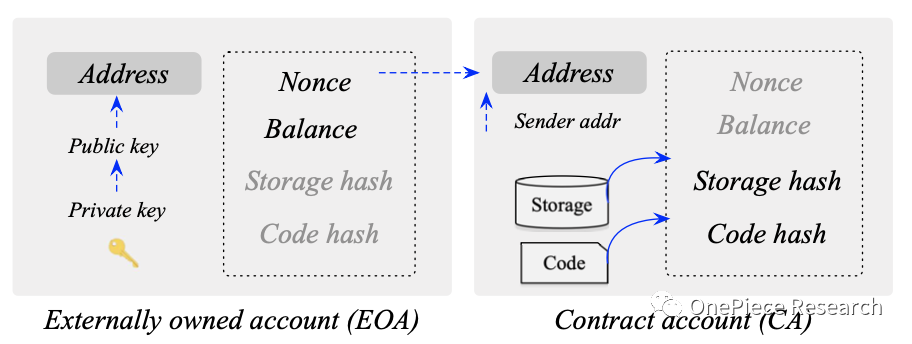
Source:《Account Abstraction, Analysed |Qin Wang∗, Shiping Chen∗ ∗CSIRO Data 61, Australia 》
trade
Ethereum transactions include sender and receiver information, digital signatures, number of transactions, amount of funds transferred, optional data, gas limits, and transaction fees. The above 2 different account types result in 2 distinct communication transaction types.
During the signing process, the transaction data is hashed and then digitally signed. The verifier verifies the validity of the signature by calculating the points on the elliptic curve. There is no need to obtain the senders private key, but only needs to provide the transaction information and public key. The recovery of the public key is achieved through the v value in the signature, ensuring the security of the signature and the efficiency of verification.
Account abstraction
Ethereums transaction structure and signature verification process reveal an important fact, that is, the account initiating the transaction must be an EOA account with a public-private key pair.
Contract accounts, due to the lack of public and private key pairs, cannot actively initiate transactions. Instead, after receiving the transaction, they automatically execute the smart contract code in the account based on the information in the transaction, or send transaction information to other accounts, or even create new smart contracts. Therefore, current wallets created by mainstream wallet applications such as Metamask are EOA accounts. However, there are some flaws in the use of EOA accounts: private key risks, limited signature algorithms, excessive signature authority, and transaction fee restrictions.
Contract accounts can store code and data and execute predefined smart contract logic to solve the above problems of EOA accounts. However, contract accounts cannot actively initiate transactions.
Account abstraction is an improvement on the above two accounts. It attempts to blur the boundaries between the two and turn it into a universal account containing complex logic, so that the account can have the functions of a CA (contract account) and an EOA account at the same time.
ERC-4337
ERC-4337 completed the account abstraction function without modifying the Ethereum consensus layer, and became the final solution adopted by Ethereum. Ultimately, the ultimate vision of off-chain matching and on-chain transactions will be realized.
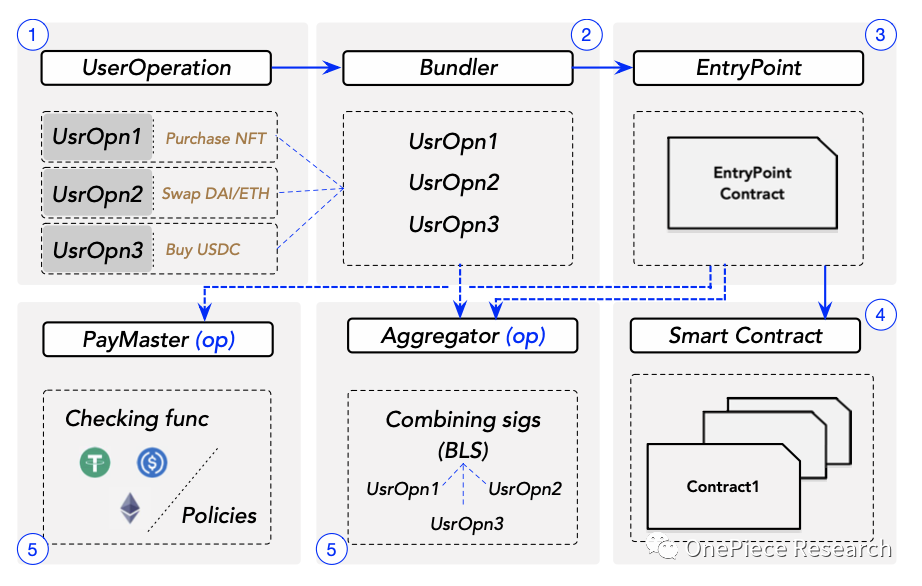
Source:《Account Abstraction, Analysed |Qin Wang∗, Shiping Chen∗ ∗CSIRO Data 61, Australia 》
UserOperation
ERC-4337 introduces a new concept called UserOperation to solve the problem of contract accounts being unable to actively initiate transactions while avoiding changing the underlying transaction types of the Ethereum protocol.
UserOperation is similar to a standard transaction, but it only represents the users intent rather than direct transaction behavior.Standard transactions are sent to Ethereums mempool (transaction pool), then combined into a complete block by the searcher and builder, and finally sent to the blockchain by the proposer, usually selecting the block with the highest reward. Unlike this, UserOperation is not a real transaction, so ERC-4337 introduces a new mempool and a role called Bundler to execute UserOperation in a decentralized manner. This innovation allows user intentions to be processed and executed without directly engaging in standard transaction processes.
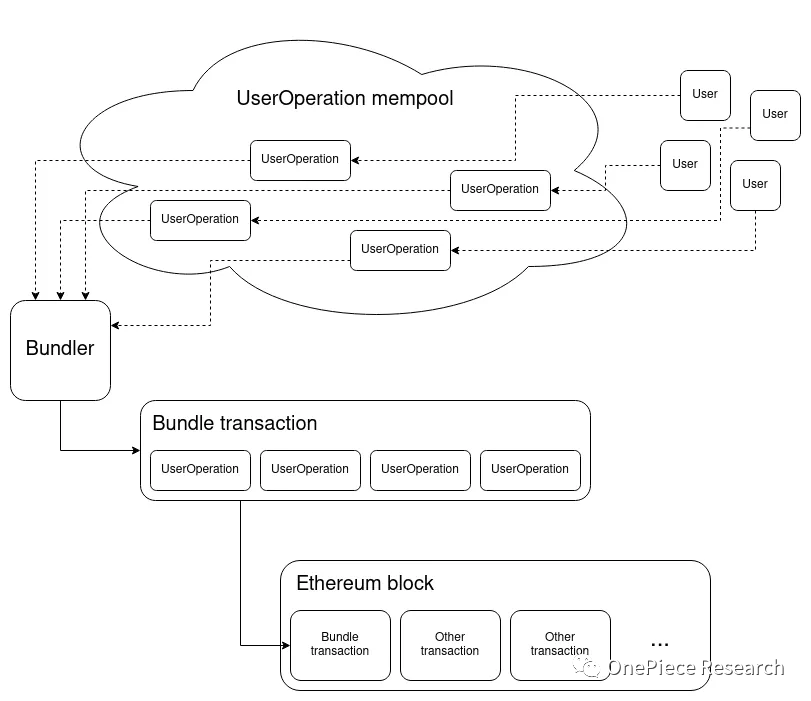
Source: ERC 4337: account abstraction without Ethereum protocol changes
Bundler
When Bundler handles UserOperation, it first performs a basic legality check, and then simulates the execution of the operation to confirm the validity of the signature. If the simulation execution is successful, the UserOperation will be added to the UserOperation mempool to wait for actual on-chain execution. To ensure consistency between simulation and actual execution, UserOperation restricts access to variables that may change during execution and only allows access to data related to the senders address. The Bundler can package UserOperations according to its own preferences, preferring operations that pay higher fees. Finally, Bundler sends the valid operation batch to the EntryPoint contract for on-chain execution.
EntryPoint
EntryPoint is a singleton contract in Ethereum, and its main task is to handle the execution of UserOperation. It has two key functions: handleOps and handleAggregatedOps, both of which first verify the UserOperation and then perform the operation. Verification includes checking accounts, signature validity and fee payments. In the execution phase, the data in UserOperation is used to call the smart contract code in the target contract account. Different smart contract wallet protocols may have different parsing and execution methods.
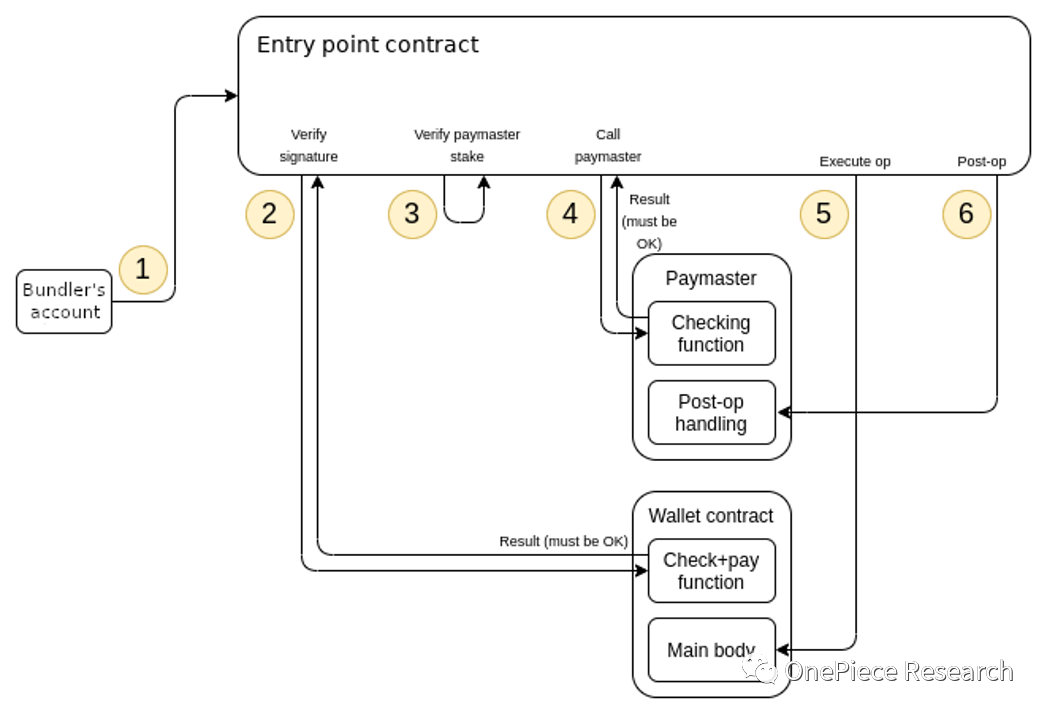
Source: ERC-4337: Account Abstraction Using Alt Mempool
data
According to SixdegreeLab’s ERC-4337 Semi-Annual Data Report:
After the ERC-4337 contract was deployed, more than 687,000 AA wallets were created on the chain, and UserOps was called more than 2 million times. However, 88.24% of AA wallets were used no more than 5 times, most of which were direct transfers or minting. NFT.
Among the 15,000 Bundlers, pimlico accounts for 43.48% and has the largest market share, while Alchemy generated the highest revenue ever, approximately US$20,000.
However, 97.18% of Bundled transactions only contain 1 UserOp, which also means that 90% of Bundlers cannot make profits through packaged transactions.
A total of 117 Paymasters paid a total of US$465,000 in gas fees for 19 million UserOps, of which Pimlico paid 43.45%.
ZeroDev dominates Wallet Factory, deploying 62.63% of accounts.
The most common way to build an AA wallet is LEGO, Paymaster, Wallet Factory and Bundler using different third parties.
It can be seen that the adoption rate of ERC-4337 still has a lot of room for growth, and the construction of infrastructure has just begun, which makes the future of AA full of possibilities. With the rise of Layer 2 and social applications, the use of AA wallets will usher in a wave of rapid growth.
The development direction of account abstraction
After understanding the basic principles of account abstraction and the architecture of ERC-4337, we will further explore the extension methods of AA. We will not go into details about the basic functions of smart contract wallets such as no private keys and no gas, but look for more possibilities in the components of AA:
Architecture
Native account abstraction
ERC-4337 is just an application layer solution adopted to deal with the current inability of Ethereum to modify the underlying consensus. Although it can popularize the abstract concept of accounts on a large scale, it ultimately uses contract accounts to interact. The additional gas consumption in the verification process, the adoption of other competing ERCs, and the ban on contract account interaction by dapps are all factors that hinder the growth of ERC-4337.
Therefore, native account abstraction, especially Layer 2 native account abstraction, is particularly important. Currently, in Layer 2 s, only Starknet and ZKSync chains support native account abstraction. As shown in the figure below, there is no Bundler and Paymaster in the native account abstraction scheme. Starknet uses Sequencer to determine the transaction sequence, pay Gas and execute it. ZKSync uses Operator to determine the transaction sequence, pay Gas, and then call bootloader to operate together.
DeBank Chain, which claims to be built based on OP Stack, will also natively integrate a system similar to account abstraction at the chain level, but the specific architecture will not be known until its mainnet is launched.

Source: Introduction to Native Account Abstraction in zkSync
NFT contract wallet
NFT contract wallet is an application layer account abstraction solution similar to ERC-4337. They enable EOA accounts to have the functions of CA accounts through NFT, instead of calling the EntryPoint contract through Bundler. Currently, there are two mainstream implementations of NFT contract wallets. Method: ERC-6551 and A3S Protocol.
ERC-6551 allows users to use the ERC-721 standard NFT in their EOA wallet as a controller to control one/multiple newly created smart contract wallets, thereby achieving plug-in contracts without modifying the ERC-721 code. way to match one/multiple smart contract accounts for existing NFTs. This method combines existing NFT with account abstraction, which not only opens up the application scenarios of NFT but also popularizes the concept of account abstraction.
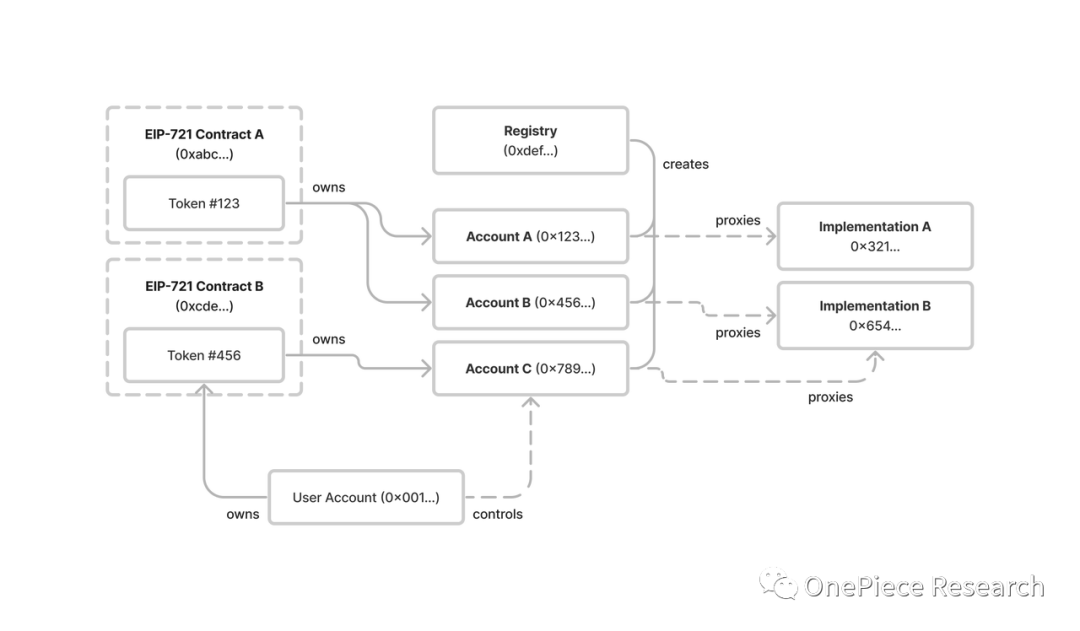
Source:《EIP-6551 》
A3S Protocol uses the NFTs own smart contract itself as a smart contract wallet, which means that the wallet assets are in the NFTs smart contract account and completely follow the NFT ownership transfer. There is no need to plug in a wallet for the NFT contract like ERC-6551. The contract account uses a shorter path to implement the NFT contract wallet, but this also means incompatibility with existing NFTs.
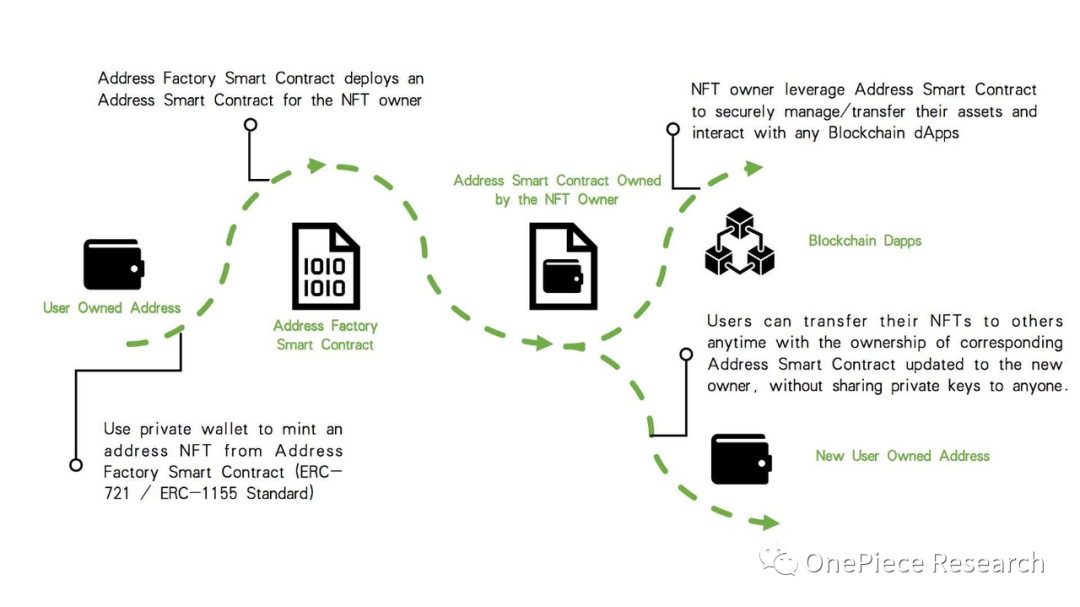
Source:《A3S Protocol Gitbook》
In terms of unifying multi-chain wallet addresses, both solutions borrow the obfuscation value Salt to obtain the same address on different EVM-compatible public chains to solve the problem of confusion in multi-chain addresses for contract accounts. This was also the problem that originally caused Wintermute to lose 20 million OP tokens by transferring to multi-signature addresses on different chains.
Modularity and multi-chain abstraction
The significance of modular account abstraction is to minimize development and maintenance costs like OP Stack, allowing wallet developers to focus more on the product itself rather than the construction and maintenance of the underlying infrastructure. Of course, the modular ecosystem established thereby is also the foundation of the modular platform, so modular account abstraction must be implemented:
Mutual composability of each module (EIP-6900 is trying to establish a standard implementation)
Diversity of module functions (signature scheme/privacy/anti-MEV/deposits and withdrawals/Intent, etc.)
Security (each module has unified standards to avoid storage conflicts)
Multi-chain abstraction (Vitalik proposed using a unified single-chain keystore contract to achieve multi-chain smart contract account coordination)
We mentioned above that we use Salt to make multi-chain smart contract account addresses consistent, but consistent addresses are only the first step. What is more important is that users have no awareness of cross-chains during operations, that is, multi-chain abstraction, which is modularity. An important step for account abstraction.
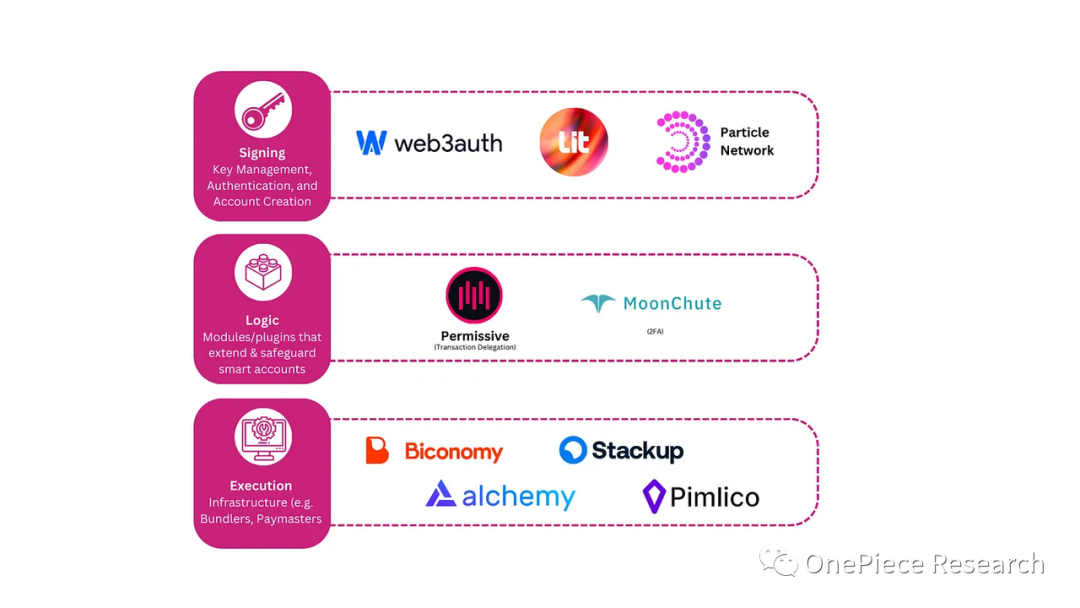
Source:《Future of Smart Accounts: Modular, Specialised & Multichain》
Signature verification
We mentioned before that any transaction on Ethereum can only rely on EOA to initiate and pay ETH as Gas. In addition, EOA can only use the ECDSA signature scheme, which makes the use of EOA very cumbersome and has a single function, as well as the risk of private key leakage. The day when quantum computers come out is also the day when Ethereum EOA accounts become lambs to be slaughtered. .
Signature algorithm
At the signature level, there are currently solutions to implement multi-signature and social recovery through smart contracts (Gnosis Safe and Argent). There are also solutions that use so-called signature abstraction to realize free interaction with contracts within a given range after one authorization (Lens Protocl). . But according to Not your keys, not your coins, we can pay more attention to the signature algorithm itself:
signature aggregation
Implement more efficient and simpler signatures through Schnorr or BLS, which not only enables multi-signature from the bottom up, but also reduces gas consumption by aggregating signatures. Of course, they all have their own problems, such as requiring additional communication rounds, not suitable for multi-signature schemes with larger values of m and n, time for large number of match verifications, etc.
Post-quantum secure signatures
Use one-time signatures such as Lamport or W-OTS to prevent others from using quantum computers to crack part of the public private key to forge messages and signatures.
UserOperation
ERC 7521 Intent Centric
When we compare the account abstraction, especially ERC-4337, and the architecture of Intent Centric, we can find that Bundler and Solver can actually be the same person. That is to say, the users interactive content UserOperation can be given by Bundler. Bundler parses the intention given by the user and proposes a matching solution path, and then confirms the legality of the path to the user through the EntryPoint contract to prevent Bundler from doing evil, and finally the execution is blocked. Verified intent path.
The combination of account abstraction and intent will enable simultaneous abstraction of accounts and interactions, achieving a user experience beyond Web2.
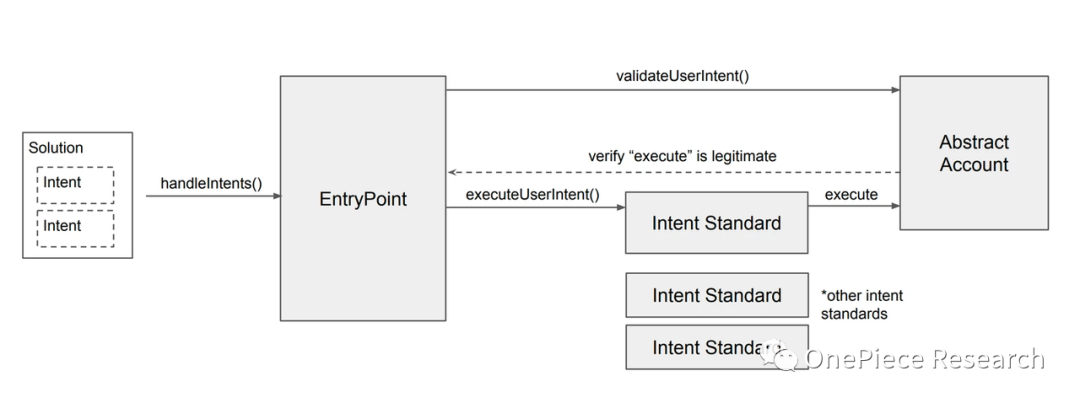
Source:《ERC-7521 》
The entire transaction process can use ZK proof technology to achieve private payment through witness/challenge and response processes. This not only allows users to prove the validity of transactions without revealing the senders real address, but also batches multiple transactions into a single proof, thereby reducing computational overhead and significantly improving scalability, which is the so-called cost reduction and efficiency improvement. Some corporate users who need to face supervision can also make transparent transactions to regulators independently to meet regulatory compliance requirements without sacrificing confidentiality.
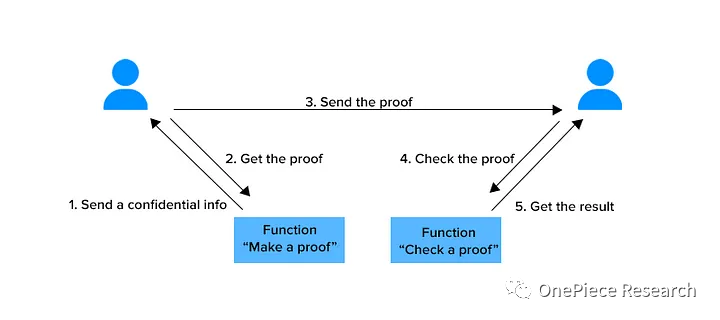
Source:《ZKPayments: Achieving Privacy and Scalability》
Bundler
Bundler MEV and Bundler Competition
Bundler MEV and Bundler Competition are both the result of insufficient infrastructure. Bundler MEV comes from Bundlers transaction packaging responsibility similar to Searcher. Bundler can change the submission order of UserOperation to make a profit, while Bundler Competition occurs when different Bundlers package the same UserOperation. . This is similar to Searchers Gas War. The Bundler whose packaged UserOperation is not on the chain spent Gas, but the transaction failed.
They can all draw on existing infrastructure, such as MEV-Boost, to open communication channels between Bundlers and between Bundlers and Block Builders. Etherspot is developing mempools p2p network for AA. UserOperations waiting to be packaged will be transmitted in this p2p network. Once packaged and processed on the chain, they will be marked and removed from the list, thus avoiding being packaged by multiple Bundlers.
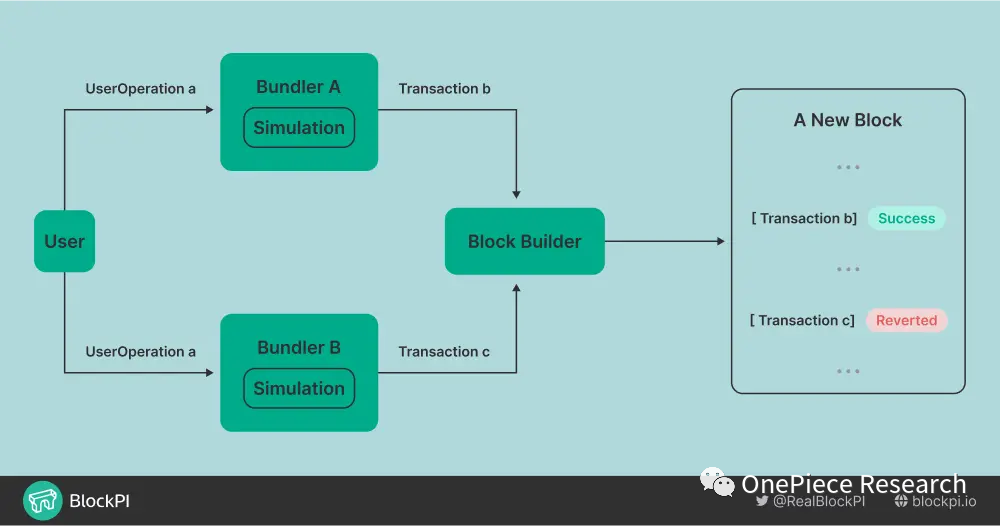
Source: Why ERC-4337 Bundler Needs to Work with Block Builders
Paymaster
Paymaster deposit and withdrawal
Paymaster can pay the Gas Fee for the user and negotiate with the user to replace it with any token or fiat currency. Therefore, it is a good solution for Paymaster to cooperate with payment service providers to provide users with deposit and withdrawal services.
The Visa team deployed two experimental Visa Paymaster contracts on the Ethereum Goerli testnet, one to explore whether users can pay fees with other tokens including USD stablecoins, and the other to try to directly sponsor transaction fees. Of course, integrating Paymaster with existing ERC-20 tokens requires using an external source or on-chain oracle to determine the token price and check whether the Paymaster contract has approval to charge the user for the specified token. Under this mature solution, direct access to the Visa card to use fiat currency to pay Gas, and even real-time conversion with ERC-20 tokens, realizing the abstraction of deposits and withdrawals will greatly reduce the entry threshold for Web2 users.
Evolution of Web3 account system and future Web3 entrance
The evolution of network traffic portals and corresponding account systems in the Web2 era reflects the rapid development of the second-generation Internet and changes in user needs.
Initially, users accessed the Internet through portals, and they were free to choose online resources listed on the portals. Then, the emergence of search engines enables users to query keywords through search engines, and search engines provide relevant results by analyzing URLs. The Web2 era has witnessed the rise of social platforms, including PC and mobile. In addition to actively using search engines to enter Web2, users can also passively access Web2 through information from PC media platforms, or independently enter Web2 through PC/mobile self-media platforms. During this period, it has experienced two processes from passive to active, and a process of information decentralization.
The account system of Web2 is also changing at the same time. From the initial SMS/MMS using mobile phone number as the account, to QQ/WeChat/Blog/Weibo to establish multiple accounts and obtain rich additional functions and independent personal network identities, these platforms have introduced Profiles and contact lists, extending user identification from a single URL to more complex user IDs and social graphs.
With the development of network and hardware technology, two types of ways to develop ones own ecology have emerged:
iOS+Apple Pay+Apple Store and WeChat Pay+Mini Program, after establishing the traffic advantages of their own accounts and payment systems, open up an area for external developers to access, thereby keeping users within their own systems. Strengthen the ecosystem.
Taobao + Alipay and Douyin + Douyin Payment develop their own accounts and payment systems based on the traffic brought by popular applications, and further integrate other applications to establish a unified account and payment system.
Both methods are effective in their own way and occupy a world. WeChat can fulfill most of the users needs in one application, while Alipay payment can also be found in major applications.
In summary, the traffic portal in the Web2 era aims to give users more initiative and decentralization, while the account system has evolved from single to rich and diverse, and has achieved its own ecological development in two ways.

Source:OP Research
Account system
The evolution of the account system in the Web3 era not only retains some of the shadows of Web2, but also presents a unique development path.
The evolution of the account system in the Web3 era continues some of the characteristics of Web2, while presenting a unique development path. In Web3, there are many types of accounts, including plug-in wallets such as Metamask, software wallets such as Math and Trust, operating platforms such as dAppOS and Gnosis Safe, as well as UniPass embedded within dApps and OKX Web3 Wallet built into exchanges .
Plug-in wallets such as Metamask are like the original text messages that can meet the most basic needs of users. Although they can be used everywhere, their functions are too single.
Software wallets such as Math and Trust, like QQ and WeChat, add various optimizations and functions to improve user experience on top of the basic functions, such as multi-account management/social sections/affiliated applications, etc.
Compared with software wallets, operating platforms such as dAppOS and Gnosis Safe have further upgraded basic functions to build another advanced account system. Similar to Apple and WeChat, they develop supporting mini programs with themselves as the core to enrich the ecosystem.
Built-in wallets in applications such as UniPass and OKX Web3 Wallet are like Alipay and Douyin Payment, which take another account and payment route. They use the traffic of popular applications to develop their own users and build an ecosystem through alliances.
Traffic entrance
We mentioned in the article Web3 Traffic Portal:
“Based on the user’s process of entering Web3, we can define Web3 traffic entrances into two major categories:
Account system (deposits, withdrawals and fund management): centralized exchanges, independent deposits and withdrawals projects, deposits and withdrawals aggregators, cryptocurrency ATMs, cryptocurrency bank cards and over-the-counter transactions (OTC); EOA, CA, MPC wallets and account abstractions (AA).
Web3 dapp (tools, social and entertainment): DEX, NFT market (Marketplace), domain name, DeSoc, copyright trading market, GameFi, X to Earn.
We still think so today, but according to Part 2, all of these portals can be part of an AA wallet. However, they also reversely divide the AA wallet adoption path into two categories, namely accounts and applications as mentioned above. Whether the user first obtains an account and then interacts with the application, or first interacts with the application and then uses the account.
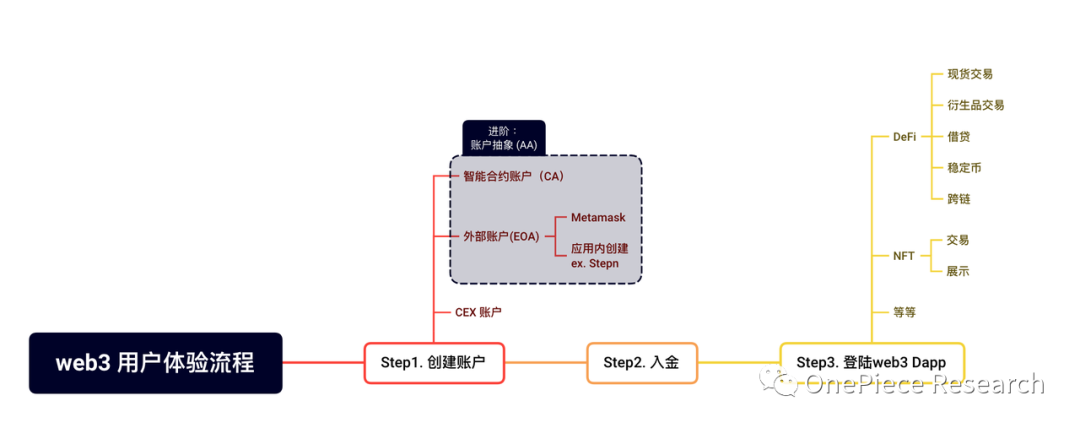
Wallet applet and Wallet as a Service
When we look at the progress of AA adoption, we can find that Instadapp’s independent AA wallet product Avocado was initially released, and then Metamask released the Snaps applet component to support some AA functions. The payment giant Visa also joined Paymaster to test the water and access Visa Card payment. Soon the social application Lens Protocol tried to establish an AA wallet through ERC-6551, and Safe was also compatible with ERC-4337 to consolidate its own mini program market. Following OKX Wallets support for the use of AA wallets, Circle chose to release its own AA wallet.
From this, it is not difficult to find that the adoption of AA is nothing more than two modes:
Own wallet releases or AA compatibility leverage wallet users and internal applets to attract and retain users.
Applications/exchanges/payment service providers use their own traffic advantages to convert users into AA wallet users.
This also leads to the part we need to discuss: Since the on-chain ecology will transform from a sellers market to a buyers market due to the emergence of AA, which model will users pay for?
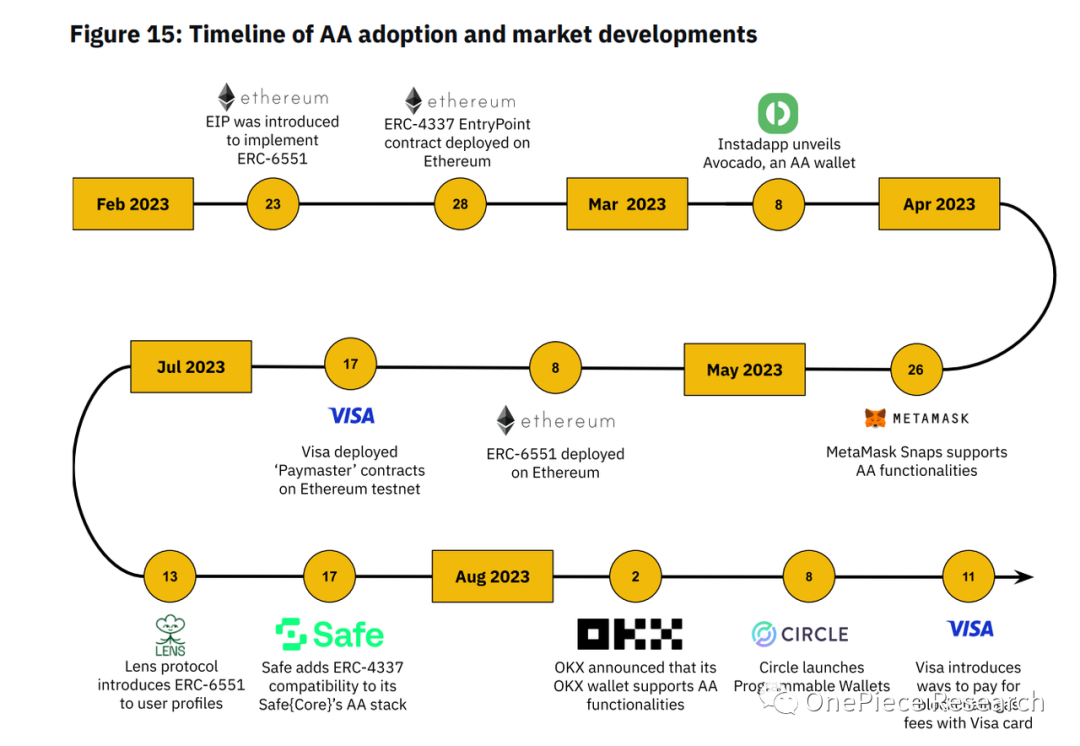
Source:《Binance Research:Account Abstractation Report》
Applets
Judging from the short-term adoption rate, the AA model of developing a small program ecosystem based on its own wallet will be more easily accepted by users. It is essentially a To C solution. Because most users currently trying AA wallets are still Web3 users, the wallet itself is not unfamiliar to them and they can use it directly without additional understanding. The rich functions and smooth operating experience can attract and retain them. . Taking MetaMasks Snaps as an example, the API interface allows third parties to develop corresponding wallet applets to interact with non-EVM chains. It seems to be attracting traffic to other wallets, but in fact it is building an ecosystem for itself and educating users. There is no doubt that the day MetaMask is fully compatible with ERC-4337 is the day it becomes the leading AA wallet.
When we take dappOS as an example:
dappOS=dappOS Account (multi-chain unified EOA)+dappOS Network.
dappOS Account: Allows users to use unified accounts based on account abstraction instead of ordinary externally owned accounts (EOA). This approach makes it possible for users to recover accounts, pre-batch transaction processing, automated execution and other functions. At the same time The multi-chain wallet aggregation method can also facilitate users to uniformly manage assets on different chains.
dappOS Network: A decentralized network that helps users automatically perform wallet and cross-chain related operations and complete the complex interaction process behind transactions.
dappOS attempts to separate the concepts of accounts, public chains and Gas Tokens so that users can have an experience similar to Web2 accounts. However, because it is still in its relatively early stage, the platform has limited cooperative dapps, but this does not hinder the growth of its user data. . Because users are motivated to enter from EOA, especially users who require multi-account and multi-chain interaction, the interactive experience after migration is greater than the migration cost. The most important thing is that once a user enters, this account system will basically never leave, because users are also being educated while using it. First of all, users who have been exposed to AA wallets from the beginning cannot use EOA wallets. Secondly, wallets such as dappOS It can meet most of the users interaction needs, and the user does not have to migrate. In the end, even if the user wants to migrate, the invisible multi-chain abstraction will make the entire migration process cumbersome.
It can be seen that formed wallet products can acquire and retain Web3 AA users faster, such as Safe, Avocado, OKX Wallet, etc.
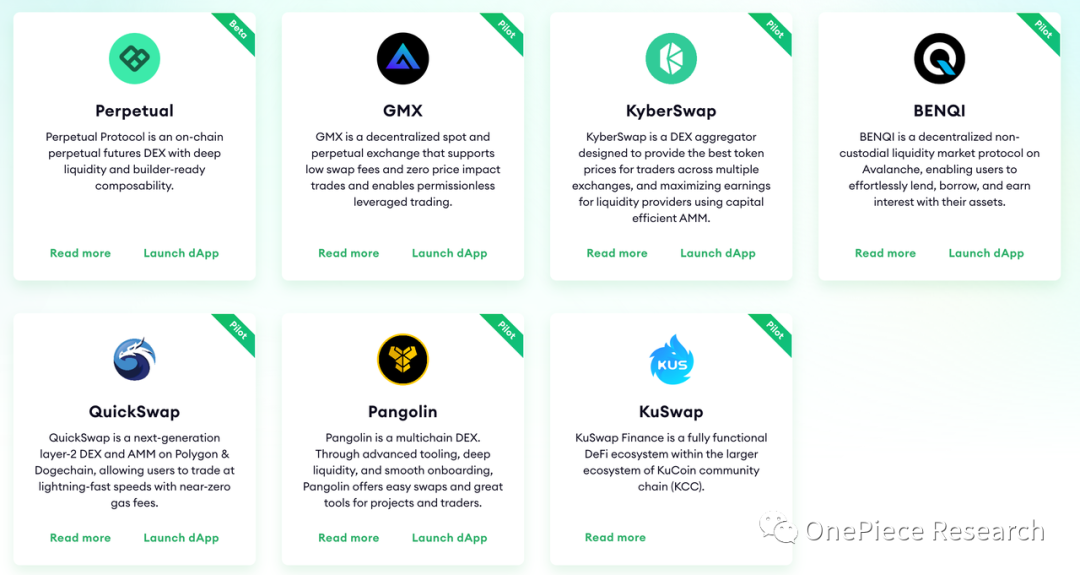
Waas
WaaS is the application route AA wallet opposite to the AA wallet that takes the mini program route. Having the application first and then the wallet is obviously a To B solution. Applications use WaaS to customize their own wallets to match product functions. Standardized WaaS modules are available for different applications to choose from. They use the applications traffic to expand their own ecology, build an AA wallet platform, and then turn to the C-side to issue customized wallets for users. Users Freely match the wallet functions you need.
Take Stepn as an example. As an out-of-circuit application, Stepn has tens of millions of users around the world, and each user has created a wallet through Stepn. If Stepn has a built-in AA wallet and uses this wallet as the core instead of just GMT tokens, it will continue to develop the ecosystem, such as the subsequent MOOAR NFT trading market, Mahjong game and Gashero. Then this AA wallet alone can bring tens of millions of incremental users to the entire Crypto market, and these users are all highly sticky users of this AA wallet, because the migration cost is extremely high for them.
The same applies to the recently popular Friend Tech. Every Twitter user can be a potential user of its AA wallet, and legal currency deposits and withdrawals and gas payment can allow users to overcome the interaction barriers of Web3 and quickly integrate into Web3.
Among the implemented products, we can focus on WaaS Pay and UniPass. These two products respectively represent the characteristics of WaaS-oriented wallets:
• WaaS Payis a smart contract account deployment platform that leverages the Safe{Core} protocol suite and Safe{Core} Account Abstraction SDK, designed for organizations seeking instant blockchain payments while prioritizing privacy. It provides a user-friendly code-free interface to customize smart contract account features such as social login, fiat on/off ramps, and gas-less transactions for recipients. With ZKBob facilitating anonymous transactions via Zero-Knowledge Proofs (ZKP), WaaS Pay ensures sensitive financial data remains secure and private. The platform is powered by Polygon ZKEVM, ensuring scalability and efficiency, while self-hosted IPFS nodes with Helia protect sensitive metadata.
• UniPassEssentially, it is also an SDK provided for third-party dapps, which allows dapps to bypass traditional account private keys and a series of signatures and Gas restrictions or the centralization of managed private keys to generate email binding addresses, and directly use UniPasss DKIM verification to implement email Controlled non-custodial accounts, and at the same time simplifying on-chain interactions through Relayer, achieving features such as gas-free/signature abstraction/social replies that greatly enhance the user interaction experience. As a scenario-driven application, UniPass chooses to use a federated social network to provide customized services for different applications while establishing an interoperable account system. Based on the interoperability of this federated social network, on the premise of providing data ownership and privacy protection, social relationships are put on the chain, and DIDs with ownership of data and assets are established to prove their own usage scenarios to attract more applications to use UniPass. The SDK goes into Web3. Users of these applications naturally become UniPass users and use it to continue interacting in Web3, with extremely high stickiness.
From this we can also see that the AA wallet of the WaaS route has more advantages in terms of growth space and acquisition of Web2 users, but this will test the product quality and BD capabilities of the team. However, once the network effect is formed, there will be growth inertia. , belongs to the type that exerts force in the later stage.
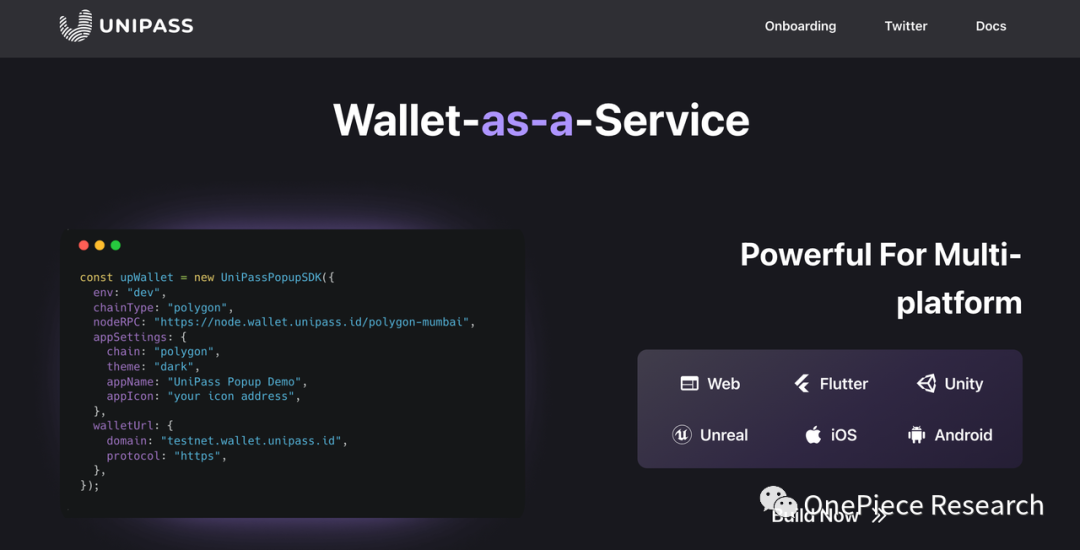
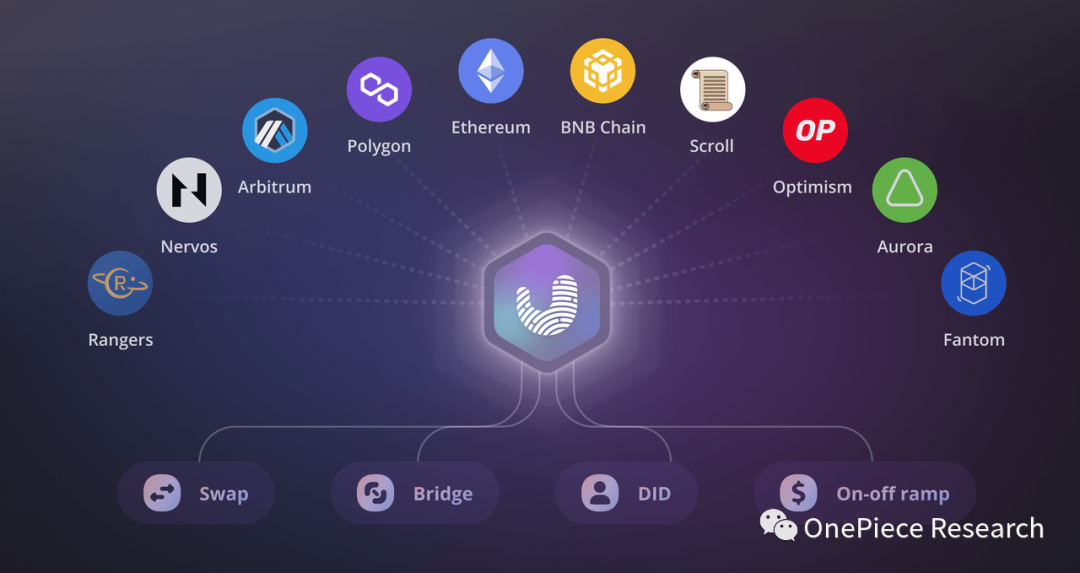
Reference
[1] Sixdegree ERC 4337 Half-year Data Reporthttps://sixdegree.xyz/research/Half-Year-Data-Report-of-ERC4337-by-Sixdegree.pdf
[2] Long article in-depth interpretation of Account Abstraction: 7-year route evolution and track maphttps://www.chaincatcher.com/article/2085142
[3] Interpretation of Binance Research Account Abstract Reporthttps://www.techflowpost.com/article/detail_12784.html
[4]《EIP-6551》https://eips.ethereum.org/EIPS/eip-6551
[5]《A3S Protocol Gitbook 》https://a3sprotocolcontact.gitbook.io/a3s-protocol/a3s-v1.0/how-a3s-v1.0-works
[ 6 ]《Future of Smart Accounts: Modular, Specialised & Multichain》https://longhashvc.medium.com/future-of-smart-accounts-modular-specialised-multichain-d04f083375a6
[7] Why ERC-4337 Bundler needs to cooperate with Block Buildershttps://learnblockchain.cn/article/6205
[8] Complete Guide to Account Abstractionhttps://news.marsbit.co/ 20230302172702633640 .html
[9] How infrastructure supports billions of users through account abstractionhttps://www.panewslab.com/zh/articledetails/24hz8399g6my.html
[10]《You Could Have Invented Account Abstraction: Part 1 》https://www.alchemy.com/blog/account-abstraction
[11] Ethereum Account Abstract Research Report: Dismantling 10 related EIP proposals and bottleneck issues affecting tens of millions of daily active usershttps://www.odaily.news/post/5183201


